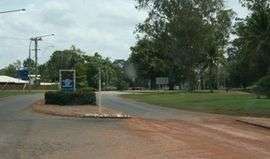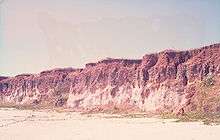Weipa, Queensland
| Weipa Queensland | |
|---|---|
 Weipa | |
 Weipa | |
| Coordinates | 12°37′S 141°52′E / 12.617°S 141.867°ECoordinates: 12°37′S 141°52′E / 12.617°S 141.867°E |
| Population | 2,830 (2006 census)[1] |
| • Density | 259.6/km2 (672/sq mi) |
| Established | 1961[2] |
| Postcode(s) | 4874 |
| Area | 10.9 km2 (4.2 sq mi) |
| Location | |
| LGA(s) | Weipa Town Authority |
| State electorate(s) | Cook |
| Federal Division(s) | Leichhardt |
Weipa /ˈwiːpə/[3] is the largest town on the Gulf of Carpentaria coast of the Cape York Peninsula in Queensland, Australia. At the 2011 census, Weipa had a population of 3,334;[1] the largest community on Cape York Peninsula. It exists because of the enormous bauxite deposits along the coast. The Port of Weipa is mainly involved in exports of bauxite. Over the last decade or so there have been occasional shipments of live cattle from the port.
Geography
Weipa is just south of Duyfken Point, a location now agreed to be the first recorded point of European contact with the Australian continent. Dutch explorer Willem Janszoon, on his ship the Duyfken, sighted the coast here in 1606. This was 164 years before Lieutenant James Cook sailed up the east coast of Australia.
History

Weipa began as a Presbyterian Aboriginal mission outpost in 1898.
Very restrictive legislation was enacted by the state of Queensland in 1911, making the Protector the legal guardian of every Aborigine and half-caste child (until he/she was 21), and the right to confine (or expel) any such person within any reserve or Aboriginal institution, and the right to imprison any Aborigine or half-caste for 14 days if, in the Protector's judgement, they were guilty of neglect of duty, gross insubordination or wilful preaching of disobedience. It also gave powers to the police to confine Aborigines to reserves to "protect them from corruption". This latter power was given by Comalco in 1957 to justify the removal of Weipa Aborigines.[4]
In 1932 the community had to relocate to its present site, at Jessica Point now called Napranum, because of malaria. It is about 12 kilometres (7.5 mi) south of the present town of Weipa. At this time most of the people were Awngthim but soon different tribes and clans were brought from Old Mapoon (when the people were forcibly removed and the settlement burnt down on 15 November 1963),[5] and other communities.
In 1955 a geologist, Henry Evans (1912–1990), discovered that the red cliffs on the Aboriginal reserve, previously remarked on by the early Dutch explorers and Matthew Flinders, were actually enormous deposits of bauxite – the ore from which aluminium is made – and to a lesser extent tungsten.
The "Comalco Act of 1957" revoked the reserve status, giving the company 5,760 square km (2,270 sq mi) of Aboriginal reserve land on the west coast of the Peninsula and 5,135 square km (1,933 sq mi) on the east coast of Aboriginal-owned (though not reserve) land.[6] Mining commenced in 1960. The mission became a government settlement in 1966 with continued attempts by Comalco to relocate the whole community elsewhere. The company then built a new town for its workers on the other side of the bay.
Climate
Weipa has a tropical savanna climate, with hot temperatures above 30 °C throughout the year. Three distinct seasons exist, the wet season, which runs from January to April, is characterized by heavy downpours on an almost daily basis. Monsoon lows and tropical cyclones cause even more extreme rainfall, up to 200 mm (8 in) in 24 hours. The dry season, running from May to September features hot and dry days, however nighttime lows are cooler and rainfall is almost non-existent. The build-up season, runs from October to December and is oppressively hot and humid, with frequent days over 35 °C. Dewpoints in the wet season average at 24 °C and 18 °C in the dry season.[7]
Rainfall during the build-up is infrequent, but when it does occur, usually falls in brief, heavy downpours associated with severe thunderstorms. These seasons are not always set however, sometimes the wet season can start as early as November or the dry season can extend as late as December and monsoonal downpours have occurred as late as May. Extreme temperatures have ranged from 9.6 °C (49.3 °F) to 38.4 °C (101.1 °F). The highest daily rainfall recorded was 327.8 mm (12.9 in) during the passage of Tropical Cyclone Oswald in January 2013.[8]
| Climate data for Weipa, Queensland | |||||||||||||
|---|---|---|---|---|---|---|---|---|---|---|---|---|---|
| Month | Jan | Feb | Mar | Apr | May | Jun | Jul | Aug | Sep | Oct | Nov | Dec | Year |
| Record high °C (°F) | 36.0 (96.8) |
35.7 (96.3) |
35.7 (96.3) |
34.5 (94.1) |
35.0 (95) |
35.5 (95.9) |
34.0 (93.2) |
35.6 (96.1) |
37.8 (100) |
38.3 (100.9) |
38.4 (101.1) |
37.3 (99.1) |
38.4 (101.1) |
| Average high °C (°F) | 31.9 (89.4) |
31.4 (88.5) |
31.7 (89.1) |
32.0 (89.6) |
31.6 (88.9) |
30.6 (87.1) |
30.4 (86.7) |
31.6 (88.9) |
33.4 (92.1) |
34.8 (94.6) |
34.7 (94.5) |
33.3 (91.9) |
32.3 (90.1) |
| Average low °C (°F) | 24.0 (75.2) |
24.0 (75.2) |
23.6 (74.5) |
22.5 (72.5) |
21.3 (70.3) |
19.5 (67.1) |
18.9 (66) |
18.8 (65.8) |
20.0 (68) |
21.4 (70.5) |
23.2 (73.8) |
23.9 (75) |
21.8 (71.2) |
| Record low °C (°F) | 20.0 (68) |
20.1 (68.2) |
19.5 (67.1) |
14.4 (57.9) |
15.0 (59) |
12.2 (54) |
10.4 (50.7) |
9.6 (49.3) |
13.9 (57) |
13.2 (55.8) |
17.8 (64) |
20.1 (68.2) |
9.6 (49.3) |
| Average rainfall mm (inches) | 451.2 (17.764) |
444.2 (17.488) |
348.7 (13.728) |
109.5 (4.311) |
16.6 (0.654) |
4.2 (0.165) |
1.8 (0.071) |
2.9 (0.114) |
5.7 (0.224) |
27.0 (1.063) |
104.0 (4.094) |
265.9 (10.469) |
1,790.1 (70.476) |
| Average rainy days | 22.0 | 21.2 | 20.4 | 10.2 | 3.6 | 1.6 | 1.2 | 1.2 | 1.1 | 2.6 | 8.2 | 16.0 | 109.3 |
| Source: The Bureau of Meteorology [9] | |||||||||||||
Bauxite mining

The present town was constructed mainly by Comalco (now called Rio Tinto Alcan), a large aluminium company, which began making trial shipments of bauxite to Japan in 1962. A railway was constructed to transport the ore from the mine at Andoom to the dump of the export facility at Lorim Point.[10] The bauxite mine is the world's largest with planned expansions increasing the margin over other mines in 2010.[2]
Facilities
Weipa has a public library, visitor's centre, swimming pool, bowling green, golf club, tennis and squash courts. There are netball and basketball courts as well as football fields. At Nanum the shopping precinct has a Woolworths supermarket, bakery, coffee shop, travel agent, clothing shop, post office, newsagency / sports shop and butchers. There is also a chemist, camping and fishing store and within walking distance is a gift shop, furniture and whitegoods store, credit union and Centrelink office. At Evans Landing you will find a hardware store and a number of mechanical workshops.[11]
See also
References
- 1 2 Australian Bureau of Statistics (31 October 2012). "Weipa (Urban Centre/Locality)". 2011 Census QuickStats. Retrieved 2016-08-17.
- 1 2 Penguin Books Australia (2002). Explore Queensland. Camberwell, Victoria: Penguin Books Australia. p. 60. ISBN 0-14-300015-2.
- ↑ Macquarie Dictionary, Fourth Edition (2005). Melbourne, The Macquarie Library Pty Ltd. ISBN 1-876429-14-3
- ↑ Massacres to Mining: The Colonisation of Aboriginal Australia, p. 34. Jan Roberts. 1981. Dove Communications. ISBN 0-85924-171-8.
- ↑ Massacres to Mining: The Colonisation of Aboriginal Australia, pp. 115–116. Jan Roberts. 1981. Dove Communications. ISBN 0-85924-171-8.
- ↑ Massacres to Mining: The Colonisation of Aboriginal Australia, p. 97. Jan Roberts. 1981. Dove Communications. ISBN 0-85924-171-8.
- ↑ "Severe Tropical Cyclone Kathy". Bureau of Meteorology. 2011. Retrieved 24 February 2011.
- ↑ "Weipa Aero". Climate statistics for Australian locations. Bureau of Meteorology. April 2013. Retrieved 11 April 2013.
- ↑ "Climate Statistics for Weipa, Queensland". Retrieved 5 May 2012.
- ↑ The Heavy-duty Industrial Railway at Weipa Buckland, John L. Australian Railway Historical Society Bulletin, June, 1975 pp143-148
- ↑ "Weipa". Centre for the Government of Queensland. Retrieved 17 January 2011.
Further reading
- Moon, Ron & Viv. 2003. Cape York: An Adventurer's Guide. 9th edition. Moon Adventure Publications, Pearcedale, Victoria. ISBN 0-9578766-4-5
- Moore, David R. 1979. Islanders and Aborigines at Cape York: An ethnographic reconstruction based on the 1848–1850 'Rattlesnake' Journals of O. W. Brierly and information he obtained from Barbara Thompson. Australian Institute of Aboriginal Studies. Canberra. ISBN 0-85575-076-6 (hbk); ISBN 0-85575-082-0 (pbk). USA edition ISBN 0-391-00946-X (hbk); ISBN 0-391-00948-6 (pbk).
- Roberts, Jan. 1981. Massacres to Mining: The Colonization of Aboriginal Australia. Dove Communications, Blackburn, Victoria. Rev. Australian ed. Previous ed: CIMRA and War on Want, 1978, London. ISBN 0-85924-171-8.
- Premier's Department (prepared by Connell Wagner). 1989. Cape York Peninsula Resource Analysis. Cairns. OCLC 220913048
- Roth, W.E. 1897. The Queensland Aborigines. 3 Vols. Reprint: Facsimile Edition, Hesperian Press, Victoria Park, W.A., 1984. ISBN 0-85905-054-8
- Ryan, Michelle and Burwell, Colin, eds. 2000. Wildlife of Tropical North Queensland: Cooktown to Mackay. Queensland Museum, Brisbane. ISBN 0-85905-045-9 (set of 3 vols).
- Scarth-Johnson, Vera. 2000. National Treasures: Flowering plants of Cooktown and Northern Australia. Vera Scarth-Johnson Gallery Association, Cooktown. ISBN 0-646-39726-5 (pbk); ISBN 0-646-39725-7 Limited Edition – Leather Bound.
- Sutton, Peter (ed). Languages of Cape York: Papers presented to a Symposium organised by the Australian Institute of Aboriginal Studies. Australian Institute of Aboriginal Studies, Canberra. (1976). ISBN 0-85575-046-4
- Wallace, Lennie. 2003. Cape York Peninsula: A History of Unlauded Heroes 1845–2003. Central Queensland University Press, Rockhampton. ISBN 1-876780-43-6
- Wynter, Jo and Hill, John. 1991. Cape York Peninsula: Pathways to Community Economic Development. The Final Report of The Community Economic Development Projects Cook Shire. Cook Shire Council.
External links
| Wikimedia Commons has media related to Weipa, Queensland. |
- "A Cape to Adventure" A description of a 4WD journey to Cape York by Roderick Eime
- Cooktown Shire Official web page
- Collection of photographs taken by Wolfgang Sievers in 1957 "Presbyterian Mission Station Weipa" held at National Library of Australia, Canberra
- University of Queensland: Queensland Places: Weipa